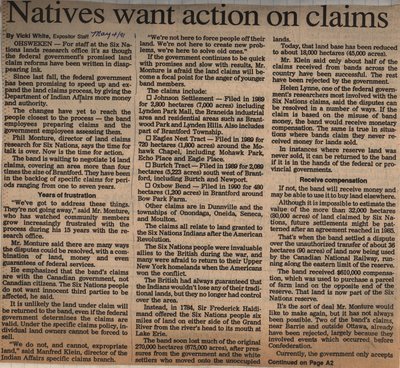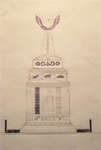"Natives Want Action on Claims"
- Publication
- Brantford Expositor, 4 May 1991
- Full Text
- Natives want action on claimsBy Vicki White, Expositor Staff
OHSWEKEN - For staff at the Six Nations lands research office it's as though the federal government's promised land claim reforms have been written in disappearing ink.
Since last fall, the federal government has been promising to speed up and expand the land claims process, by giving the Department of Indian Affairs more money and authority.
The changes have yet to reach the people closest to the process - the band employees preparing claims and the government employees assessing them.
Phil Monture, director of land claims research for Six Nations, says the time for talk is over. Now is the time for action.
The band is waiting to negotiate 14 land claims, covering an area more than four times the size of Brantford. They have been in the backlog of specific claims for periods ranging from one to seven years.
Years of frustration"We've got to address these things. They're not going away," said Mr. Monture, who has watched community members grow increasingly frustrated with the process during his 15 years with the research office.
Mr. Monture said there are many ways the disputes could be resolved, with a combination of land, money and even guarantees of federal services.
He emphasized that the band's claims are with the Canadian government, not Canadian citizens. The Six nations people do not want innocent third parties to be affected, he said.
It is unlikely the land under claim will be returned to the band, even if the federal government determines the claims are valid. Under the specific claims policy, individual land owners cannot be forced to sell.
"We do not, and cannot, expropriate land," said Manfred Klein, director of the Indian Affairs specific claims branch.
"We're not here to force people off their land. We're not here to create new problems, we're here to solve old ones."
If the government continues to be quick with promises and slow with results, Mr. Monture is afraid the land claims will become a focal point for the anger of younger band members.
The claims include:
Johnson Settlement - Filed in 1989 for 2,800 hectares (7,000 acres) including Lynden Park Mall, the Braneida industrial area and residential areas such as Brantwood Park and Lynden Hills. Also includes part of Brantford Township.
Eagles Nest Tract - Filed in 1989 for 720 hectares (1,800 acres) around the Mohawk Chapel, including Mohawk Park, Echo Place and Eagle Place.
Burtch Tract - Filed in 1989 for 2,089 hectares (5,223 acres) south west of Brantford, including Burtch and Newport.
Oxbow Bend - Filed in 1990 for 480 hectares (1,200 acres) in Brantford around Bow Park Farm.
Other claims are in Dunnville and the townships of Onondaga, Oneida, Seneca, and Moulton.
The claims all relate to land granted to the Six Nations Indians after the American Revolution.
The Six Nations people were invaluable allies to the British during the war, and many were afraid to return to their Upper New York homelands when the Americans won the conflict.
The British had always guaranteed that the Indians wouldn't lose any of their traditional lands, but they no longer had control over the area.
Instead, in 1784, Sir Frederick Haldimand offered the Six Nations people six miles of land on either side of the Grand River from the river's head to its mouth at Lake Erie.
The band soon lost much of the original 270,000 hectares (675,000 acres), after pressures from the government and the white settlers who moved onto the unoccupied lands.
Today, that land base has been reduced to about 18,000 hectares (45,000 acres).
Mr. Klein said only about half of the claims received from bands across the country have been successful. The rest have been rejected by the government.
Helen Lynne, one of the federal government's researchers most involved with the Six Nations claims, said the disputes can be resolved in a number of ways. If the claim is based on the misuse of band money, the band would receive monetary compensation. The same is true in situations where bands claim they never received money for lands sold.
In instances where reserve land was never sold, it can be returned to the band if it is in the hands of the federal of provincial governments.
Receive compensationIf not, the band will receive money and may be able to use it to buy land elsewhere.
Although it is impossible to estimate the value of the more than 32,000 hectares (80,000 acres) of land claimed by Six Nations, future settlements might be patterned after an agreement reached in 1985.
That's when the band settled at dispute over the unauthorized transfer of about 36 hectares (90 acres) of land now being used by the Canadian National Railway, running along the eastern limit of the reserve.
The band received $610,000 compensation, which was used to purchase a parcel of farm land on the opposite end of the reserve. That land is now part of the Six Nations reserve.
It's the sort of deal Mr. Monture would like to make again, but it has not always been possible. Two of the band's claims, near Barrie and outside Ottawa, already have been rejected, largely because they involved events which occurred before Confederation.
Currently, the government only accepts claims arising from agreements negotiated with the federal government after 1867, when the country was united.
The band's railway claim was the only one which fit that requirement.
The Prime Minister has promised that restriction will soon be lifted, and Ms. Lynne said the band would be free to ask the government to reconsider the two rejected claims if the policy is changed.
If that happens, the band's claims would join about 260 others currently in the system.
The Mississaugas of the New Credit band is also planning to join the queue, by re-submitting a claim for 80 hectares (200 acres) of land on the north shore of the Credit River, which had been suspended by the federal government.
Researching claimsThe band is researching several other claims, which are expected to be filed soon.
Mr. Monture said most of the Six Nations claims are for land the band leased to white settlers, but refused to sell.
For example, the band has a claim for 3,072 hectares (7,680 acres) along Highway 6, the Hamilton-Port Dover Plank Road, in Seneca and Oneida Townships.
In the 1830s, the Six Nations Confederacy chiefs, the traditional leaders of the community, refused to sell the land. They did agree to lease plots for 42 years, with renewals.
Today, there is no money coming in from those leases, and the band wants to know why.
In other instances, Mr. Monture said, the Confederacy chiefs were intimidated and coerced into signing documents to surrender their land.
In the 1840s, as white settlers were increasingly finding their way onto the Six Nations lands, the government encouraged the chiefs to surrender all land they weren't occupying at the time.
The settlers, who were proceeding to build homes and set up farms, protested loudly when the chiefs said they would lease, not sell, their land.
The government continued pressing for a surrender. "The Indians were called everything, intimidated in any way possible," said Mr. Monture.
"The Indian agent was calling them ignorant... and basically saying that if they didn't surrender they couldn't prevent the land from being taken anyway."
A claim for land along Grand River which was flooded in the 1830s when the Welland Canal Company built a feeder line to the Welland Canal should be one of the easiest to resolve, said Mr. Monture.
According to the band's research, the federal government agreed in 1884 to pay the band $28,672 to compensate for the flooded land.
However, Mr. Monture said, the governments of Upper and Lower Canada refused to consent to this payment.
They were afraid they would then be liable for other lost lands. The issue has never been resolved.
The Town of Dunnville has proposed building lift locks on the land under dispute.
"If that project gets the OK, and our land claim is still unresolved, we'll have to step in at some point," said Mr. Monture.
Dunnville Mayor Bernie Corbett said he understands the band's position, and he has pleaded with federal and provincial governments to settle the claim.
"We're just a pawn in somebody's big game, and the losers will be our community and the Indian band," if the project is stalled, he said.
- Creators
- White, Vicki, Author
- DiStefano, Louie, Artist
- Media Type
- Newspaper
- Item Types
- Articles
- Clippings
- Description
- "For staff at the Six Nations lands research office it's as though the federal government's promised land claim reforms have been written in disappearing ink."
- Date of Publication
- 4 May 1991
- Subject(s)
- Personal Name(s)
- Monture, Phil ; Klein, Manfred ; Lynne, Helen ; Corbett, Bernie.
- Corporate Name(s)
- Department of Indian Affairs ; Lynden Park Mall ; Canadian National Railway ; Welland Canal Company.
- Local identifier
- SNPL002944v00d
- Language of Item
- English
- Geographic Coverage
-
-
Ontario, Canada
Latitude: 43.06681 Longitude: -80.11635
-
- Creative Commons licence
 [more details]
[more details]- Copyright Statement
- Public domain: Copyright has expired according to Canadian law. No restrictions on use.
- Copyright Date
- 1991
- Copyright Holder
- Brantford Expositor
- Contact
- Six Nations Public LibraryEmail:info@snpl.ca
Website:
Agency street/mail address:1679 Chiefswood Rd
PO Box 149
Ohsweken, ON N0A 1M0
519-445-2954



